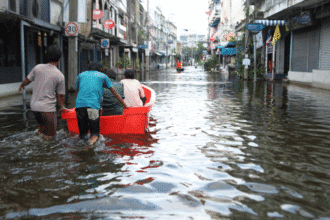The current Air India crash incident has elicited international concerns as aviation specialists, regulators, and the airline authorities engage in working out what may have caused the loss of lives in the deadly Boeing 787-8 incident. Last week, a flight (AI171)bound to London, which was to take off from Ahmedabad, crashed less than half a minute after takeoff, resulting in nearly 270 deaths on board. The engines of the aircraft, the black box records, and the service records have become the focus of the investigation.
- Why is there scrutiny of the airplane engines?
- Is Safety Curable by the Age of the Engine?
- What Part Do Black Boxes Have in an Investigation?
- What Is Air India Doing to Deal with the Tragedy?
- What Have the Regulators Done Since the Crash?
- What are the future ramifications of his incident on Air India?
- Is There Anything to Learn from the Global Aviation Industry?
- Final Thoughts
Concerning the initial diagnoses, it seems that one of the engines was a new one installed in March 2025, and the other one was old but was still in its maintenance window, and no flags concerning safety had been raised. But as speculation runs rife, investigators are also encouraging everyone to be patient, awaiting the final release of key flight data that will hopefully help them put together a clearer picture of the last moments on board the flight.
Why is there scrutiny of the airplane engines?
One aspect of the Air India crash is an evaluation of the state of the two Genx-1B engines used by the plane. These GE aerospace engines are available in a digital monitoring system dubbed Full Authority Digital Engine Control (FADEC), which runs on an engine. As opposed to the standard maintenance schedule, FADEC constantly evaluates the condition of the engine and notifies engineers in case of any interference.
The right engine was less than two months old, whereas the left one had passed service in 2023 and was planned to undergo the next check in December 2025. Airline executives state that both engines had no history of problems, and investigators are examining every minute detail of the FADEC, as well as parts of the actual engine itself, to isolate and identify any misbehavior that could have taken place during the flight. Hers is the link to our article on the Plane Crash.
Is Safety Curable by the Age of the Engine?
Not necessarily. Indeed, the industry professionals find the age of an engine as a narrow component of assessing the reliability of the machine or its safety. The Genx-1B engines are durable, and they contain sensors that are embedded, which monitor real-time usage and performance. Nevertheless, certain components of the engines ( e.g., Life Limited Parts (LLPs) ) are very limited in the operational cycles they can have, depending on the flights of the airplane.
The engine cycle begins when the engine is switched on and ends when the engine is off. Generally, LLPs are rated at 15,000 and 20,000 cycles. Investigation related to the crash of Air India is giving a close examination to the number of cycles every engine has served and the status of such LLPs. This will help to know whether there was a warning failure of any of the internal components.
What Part Do Black Boxes Have in an Investigation?
The black boxes of the aircraft, that is, the flight data recorder (FDR) and the cockpit voice recorder (CVR), have been retrieved, and analysis is in progress. These computers retain vital data regarding the speed, altitude, and the performance of the engine, as well as the cockpit discussions during the time before the crash occurs.
The black boxes will provide conclusive evidence on what could have led to the incident, according to the leadership of Air India. The media and society are being urged by authorities not to jump to conclusions yet until these recordings have been thoroughly analyzed. This data is important in the Air India crash investigation because it forms a proper account of what happened.
What Is Air India Doing to Deal with the Tragedy?
Air India has also responded to the crash by temporarily decreasing the operations of 15 percent of international flights using wide-body airplanes. This will last till mid-July in a wider safety review. According to the airline, it has been compelled to take this step because of what it calls compounding circumstances presented by intensified safety checks and tensions in the region.
Moreover, Air India has been able to inspect 26 of its 33 Boeing aircraft in terms of safety. Aircraft subjected to inspection have been released to service. The other planes, together with the fleet of Boeing 777 aircraft, are slated to face such tests in the next few days. On the part of Air India, this action shows efforts to take measures to protect passengers and restore confidence in the current Air India crash investigation.
What Have the Regulators Done Since the Crash?
The civil aviation regulator of India moved with speed and directed further safety checks on all the Boeing 787s used in Air India. Such practices are viewed as preventative, and the idea behind them is finding the roots of a problem that might not be identified otherwise.
Regulators think it is wise to conduct these checks now, when it is still early to complete the investigation of the Air India crash, to enforce safety assurance in further operations. Additional regulations or recommendations can come based on the ultimate conclusions in terms of procedures undertaken by pilots, new inspection of engines, or maintenance procedures.
What are the future ramifications of his incident on Air India?
Air India is feeling the pinch, and this unfortunate accident shows up at a critical moment. The airline is in a state of significant change, as it used to be a state-owned company, but now it has been modernized into a privately owned company in the Tata Group. The crash may interfere with its turnaround aspirations, at least unless it manages to win back the faith of people soon enough.
In spite of the impending short-term disruption, the immediate response of the airline to its operations and safety can reduce the consequences of long-term reputational losses. However, findings of the Air India crash will be central determinants of the ways in which the company will continue to act.
Is There Anything to Learn from the Global Aviation Industry?
Indeed, even now, this event is already raising bigger debates in the world of aviation. Heavy dependent on the digital monitoring systems, such as FADEC, although efficient, should be supplemented with heavy physical inspections and part replacement. The airline companies are further advised that even a showing of a clean history of aircraft requires careful observation; this is particularly when alterations are made, such as the installation of new engines.
The example of this crash presents the lesson that various seemingly insignificant problems, which are not considered during mitigation, may cause such a devastating effect. It states the importance of thorough safety checks and improved communication between flight operators and the technical crews.
Final Thoughts
The Air India crash investigation is a turning point not only for the company but also for the airline industry across the world. It also presents the elaborate interplay of drivers, which dictate the condition of aircraft, including engine cycles, data monitoring systems, among others. Although people are speculating, it will indeed only be a thorough examination of the black box data and analysis of the engine that is going to make the difference.
The tragedy also highlights the need for airlines globally to take the preventive bordering issue seriously into consideration, whether a plane is in service or not. In sum, the results of the Air India crash investigation may affect safety guidelines and regulatory norms in the whole aviation sector.








